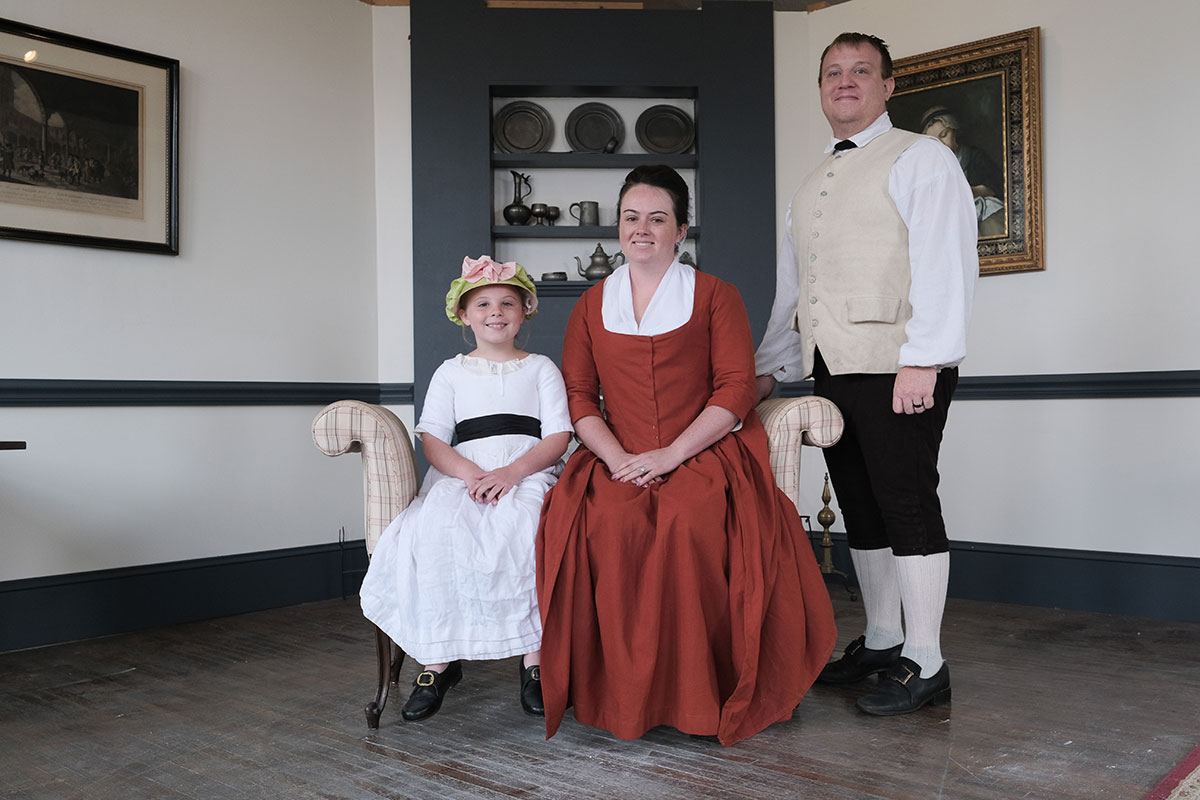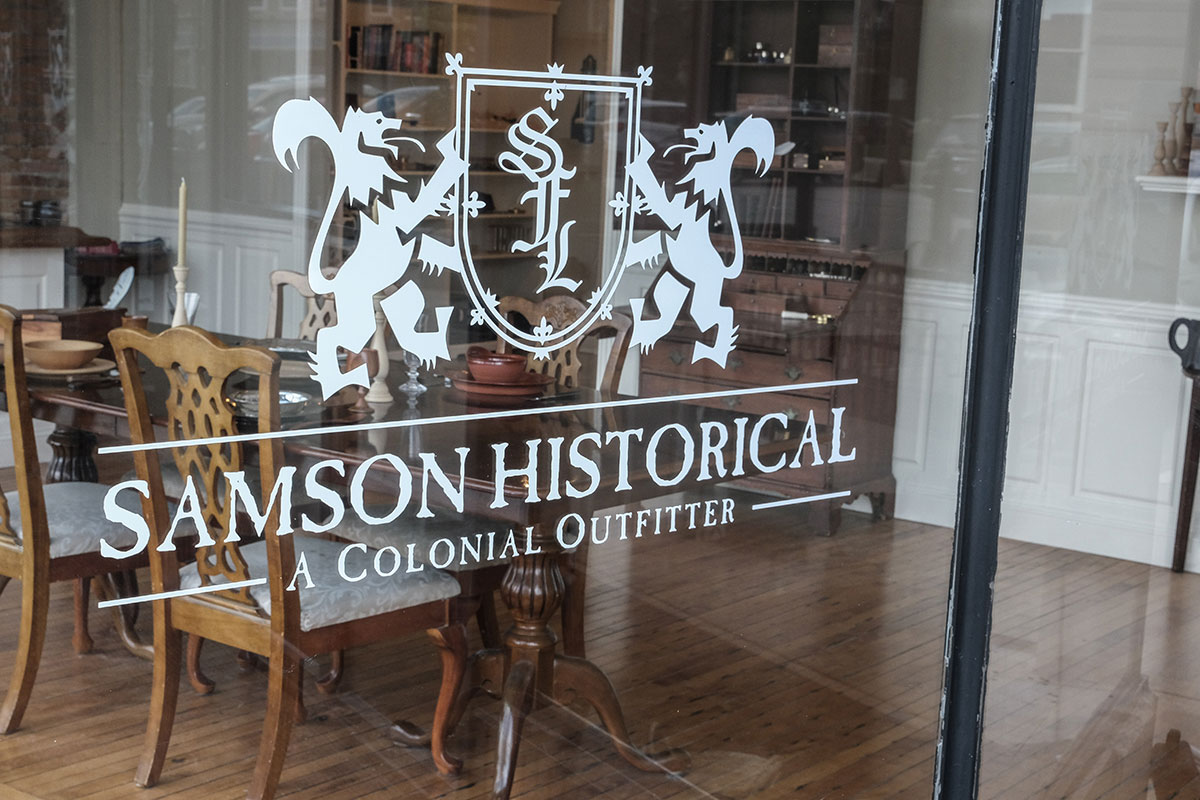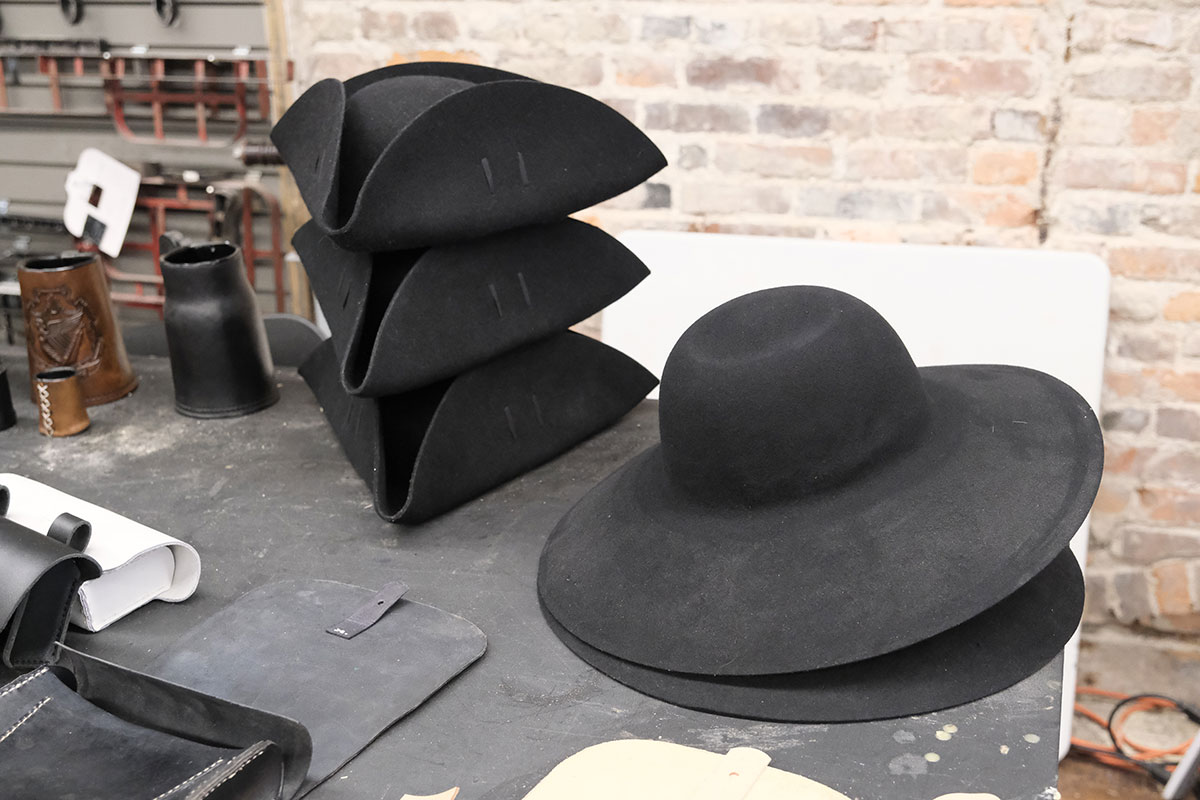Subscriber Benefit
As a subscriber you can listen to articles at work, in the car, or while you work out. Subscribe NowCasey Samson first stepped into the 18th century before he could walk. Now, with his wife, Abbie, he makes it his life’s work to help others travel to the Revolutionary War era.
The Samsons own and operate Samson Historical, a colonial outfitter producing and selling more than 800 varieties of mostly late-18th-century-era clothing, accessories and living-history supplies in two attached buildings they purchased on the east side of the courthouse square in Lebanon.
“We have five floors of history right here, so it’s pretty fun,” Casey said as he walked through a warehouse full of goods on a recent Monday morning.

The Samsons, both Lebanon natives, employ 14 workers and produce many of their own products. They also work with 40 artisans from around the world who specialize in trades that are rapidly disappearing, like blacksmithing, tinsmithing, pottering and pewtering. The husband-wife duo views their role as preserving trades and traditions for the next generation.
“There’s a lot of those trades that are at risk,” Casey said. “We really try to work with artisans so they can keep their craft alive.”
He pointed to a pewter dinner plate made from an original 18th-century mold before he walked to a collection of clay pipes produced by a fifth-generation pipe-maker in Germany. A display of writing utensils is filled with brass porte-crayons (pencils) made in-house, while a shelf is full of leather mugs crafted by Samson Historical’s leatherworker.
Waistcoats, frocks, breeches, gowns, bonnets and bum rolls, sewn by seamstresses on the second floor, will be worn not just by reenactors but also by movie actors and people who make old-style dress and lifestyle parts of their everyday lives.
“The goal is that when you walk out of here, you could almost walk right into an 18th-century painting,” Casey said.
Samson Historical first sold children’s clothing in 2022, inspired both by demand from customers and by their now-8-year-old daughter, Payton, who judged entries in a contest to find a logo for the new line of business. The winner was George the Lion, whom Payton named for her favorite historical figure, George Washington.
(“Oh, yeah! That was my idea!” she boasted. “I’m awesome.” “Way to be humble,” her dad replied.)
“It’s really difficult to find kids’ clothing,” Casey said. “There’s just not a lot of people making it, and so we decided, ‘Let’s try this,’ and it’s really taken off.”
Samson Historical sells products both at the Lebanon store, which has a first-floor showroom, and online through a website that was revamped during the pandemic to draw more people to the business.
The Samsons this year published a 162-page catalog that was mailed to 30,000 addresses and filled with every 18th-century accoutrement imaginable. For images both online and in the catalog, the couple hires models and invites children of family friends to a multiday photo shoot in a third-floor studio outfitted with 18th-century furniture, paintings, prints and a mud fireplace. Wall colors in the studio are sourced from Colonial Williamsburg.
People living in Indiana purchase about 8% of Samson Historical’s goods. The store receives visits from out-of-towners looking for the right outfit or tools to bring to one of the many fall festivals in Indiana, such as the Feast of the Hunters’ Moon at Fort Ouiatenon near West Lafayette and the Spirit of Vincennes Rendezvous in Vincennes.
“The Midwest is big on cottage craft and cottage industry,” Abbie said. “Throughout the entirety of the Midwest, you have all these people and artisans doing crafts and heritage crafts that make it easy to connect and get things into this space.”
The Samsons regularly go on the road to festivals, not in character, but as merchants, with a 24-foot branded trailer and a 35-foot-by-40-foot tent. They take a smaller tent and a van called “The History Machine” to some events.
They’re also preparing for a big ramp-up in production over the next decade when the United States will recognize multiple 250th anniversaries of the Revolutionary War era, highlighted by the country’s semiquincentennial on July 4, 2026.
“We’re expecting that to really propel us to the next level in our garment production,” Casey said. “It’s going to be a pretty big undertaking for the next few years, but it’ll be fun.”
A family affair
The roots of Samson Historical date to 1982 when Casey’s grandfather, Jack Samson, set up a wedge tent along the banks of the Wabash River at Fort Ouiatenon and sold leather drinking vessels (known as jacks) under the business name “Jack’s Jacks” to people attending the Feast of the Hunters’ Moon.
Jack Samson later opened a shoe repair shop on the east side of Indianapolis in Irvington. In 1990, IBJ reported on Jack’s Shoe Repair, writing that “he prefers to think of himself as a cordwainer—an archaic term for leather-worker and the trade that Samson represents in historical reenactments.” It was a craft also undertaken by his son Bob, who is Casey’s father.
After Casey was born in 1992, his father and grandfather took him to his first event, the Feast of the Hunters’ Moon, when he was 8 months old.
One of Casey’s formative memories is that his interest in history took off after he visited a drive-in movie theater and watched “The Patriot,” a 2000 Revolutionary War film starring Mel Gibson as a conscientious objector drawn into the war after the British captured his son.
“And I just thought, ‘Man, I just wish I could do that every week,’” he said. “At the time, we were just doing two or three events a year, and I was like, ‘This would be so much more fun to do it all the time.’”
Casey took over the leather-making business from his father in 2011, and tested it for a couple of years with Abbie, whom he married in 2015.
When they were ready to make the leap for good, Casey quit his full-time job as an emergency medical technician, and Abbie later shifted her public relations and marketing skills to the family business.
They expanded the company’s product offerings, first to beeswax candles and then to men’s and women’s clothing. They later added a line of women’s clothing designs purchased from Turkey Roost Trading, a business of family friends Annie and Verna Metz.
The adult clothing offerings include garments that fit the Regency period, in the early 19th century.
In 2014, the Samsons opened a storefront at 119 N. Meridian St. in Lebanon and gradually accumulated more space before they purchased their original two-story building and an adjacent three-story building two years ago.
Along with Payton, who is homeschooled and travels with her parents to festivals, the family is completely immersed in their business. They live on the second floor of one of their buildings.
Payton, a fan of the Broadway musical “Hamilton,” already has a well of historical facts deeper than most adults. She likes to share her favorite facts that she learned from places like George Washington’s home at Mount Vernon in Virginia.
“George Washington’s teeth were not wooden,” she said. “They were hippo teeth! Which I’m pretty sure had to be cut down because they have a big mouth.”

‘Pretty special to me’
Casey said he is reminded why he chose this life when he is in his favorite settings.
“Sometimes when you’re at an event with the lighting at the right time of the day and the right people around you, you really feel like you’re immersed in it and you’re back in that time,” he said. “That’s pretty special to me, and so that’s why I was like, ‘This is what I want to do.’”
While the Samsons enjoy visiting the 18th century, they would not want to live there. Abbie said she could endure longer than Casey, but not too long.
“When the hard winter came, I would be done,” she said. “A good bath is my favorite thing at the end of a long day. And the work that would have to go into that, I would not be a happy camper.”
And Casey likes modern technology too much to stay forever in an era long before the invention of the incandescent light bulb. He said 18th-century life made for a harder existence.
“I like the romantic version of that, but in reality, no,” he said. “Indoor plumbing is really nice. Electricity is nice. And air-conditioning is prime. To take a snapshot, if I could time-travel for a day, hands down. But I think you can’t live the life that we know today in the 18th century. I think even the reenactors and living historians of today would have a heck of a time living in the 18th century.”
While Samson Historical is rooted in the 18th century, its success is driven by modern business techniques.
In 2020, the Samsons for the first time published thousands of copies of their catalog, which sat unread and undelivered on shelves in a warehouse after the pandemic began. Casey said his family was “on the brink of losing our entire business.”
They were used to working 60 to 80 hours a week, but they were suddenly stuck in their own harsh season, looking for a way to survive.
So, they got to work rebuilding their website and focusing on search-engine optimization, email campaigns and text-messaging marketing to access people from anywhere around the globe, which Casey said springboarded the company to the next level.
“We’re very much a 21st-century business for the 18th-century world,” he said. “We’re constantly trying to make sure that we’re advertising to the 21st-century customer. They’re not 18th-century customers. I can’t put an ad in the local paper saying we have new waistcoats for sale.”
Modern technology also helps the Samsons research and perfect their products. Casey said he learns something new almost every day to add to or change about an item.
“We’re constantly researching. We’re constantly learning. Ten years of doing this, we have this large amount of information in our heads, but you never know the full story,” he said. “We as a collective community, we are learning more now about the 18th century faster than we ever have before because the information is readily available.”

The 250th is coming
On the second floor of Samson Historical, seamstresses Kris Byers, Isabella Campins and Molly Scheerer are working on a tight deadline sewing petticoats for a movie whose title they can’t divulge.
It won’t be the first time outfits created at Samson Historical have been used on screen. Actors and actresses on Netflix’s series “Locke & Key” and in the movie “Hocus Pocus 2” wore Samson Historical-made outfits.
“It still amazes me to know that the things that I make are going on other people, and people are actually wearing the things that I make,” Campins said.
The Samsons recently hired two more seamstresses as part of preparations for the explosion of interest in the Revolutionary War era they expect starting next April with the 250th anniversary of the battles of Lexington and Concord.
Abbie and Casey said they recently realized that the semiquincentennial won’t just be the 250th anniversary of the signing of the Declaration of Independence but will include eight years of 250th anniversaries from 2025 to 2033.
They said the country’s bicentennial in 1976 sparked decades of interest in the Revolutionary War and the 18th century, which led to the festivals and reenactment events they enjoy today. Given the expected growth in interest, they hope to open a small museum within 10 years to display their collection of 18th-century artifacts and goods.
“I don’t think it’s quite hit people yet,” Casey said. “I think next year will be a big year, but we are seeing it. We’re having events planned already across the country.”
For Abbie, she said the series of 250ths will be yet another opportunity to learn more about history.
“I’m excited to have the questions that I didn’t know I had answered,” she said. “And to come up with the questions that we never had the opportunity or the reason to think about before.”•
Please enable JavaScript to view this content.

